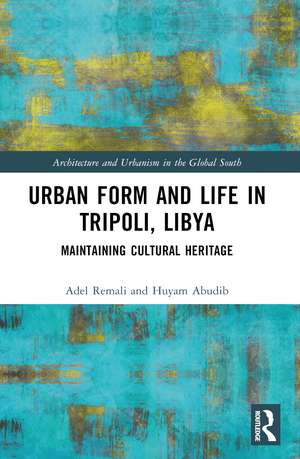Urban Form and Life in Tripoli, Libya: Maintaining Cultural Heritage: Architecture and Urbanism in the Global South
Autor Adel Remali, Huyam Abudiben Limba Engleză Paperback – 27 mai 2024
Preț: 259.98 lei
Preț vechi: 311.41 lei
-17% Nou
Puncte Express: 390
Preț estimativ în valută:
49.75€ • 51.75$ • 41.07£
49.75€ • 51.75$ • 41.07£
Carte tipărită la comandă
Livrare economică 14-28 aprilie
Preluare comenzi: 021 569.72.76
Specificații
ISBN-13: 9780367568818
ISBN-10: 0367568810
Pagini: 270
Ilustrații: 140
Dimensiuni: 156 x 234 mm
Greutate: 0.45 kg
Ediția:1
Editura: Taylor & Francis
Colecția Routledge
Seria Architecture and Urbanism in the Global South
Locul publicării:Oxford, United Kingdom
ISBN-10: 0367568810
Pagini: 270
Ilustrații: 140
Dimensiuni: 156 x 234 mm
Greutate: 0.45 kg
Ediția:1
Editura: Taylor & Francis
Colecția Routledge
Seria Architecture and Urbanism in the Global South
Locul publicării:Oxford, United Kingdom
Public țintă
PostgraduateCuprins
Introduction
PART I: URBAN MORPHOLOGY, URBAN FORM AND URBAN LIFE
Chapter 1. Theories and Schools of Urban Morphology
Chapter 2: Urban Form and urban Life
Part II: TRIPOLI’S HISTORY AND ISLAMIC PRINCIPLES
Chapter 3. Historical evolution of the city of Tripoli
Chapter 4. Islamic Principles of Built Environment
Part III: INVESTIGATING THE ESSENCE OF TRIPOLI’S CITY CENTRE
Chapter 5. Measuring Urban Components at the Neighbourhood Scale: Street Network and Block Structure
Chapter 6. Analysing the Street Front: Quality and Social Life
Chapter 7. Analysing the Street Edge: Constitutedness and Social Life
Conclusion
References
Index
PART I: URBAN MORPHOLOGY, URBAN FORM AND URBAN LIFE
Chapter 1. Theories and Schools of Urban Morphology
Chapter 2: Urban Form and urban Life
Part II: TRIPOLI’S HISTORY AND ISLAMIC PRINCIPLES
Chapter 3. Historical evolution of the city of Tripoli
Chapter 4. Islamic Principles of Built Environment
Part III: INVESTIGATING THE ESSENCE OF TRIPOLI’S CITY CENTRE
Chapter 5. Measuring Urban Components at the Neighbourhood Scale: Street Network and Block Structure
Chapter 6. Analysing the Street Front: Quality and Social Life
Chapter 7. Analysing the Street Edge: Constitutedness and Social Life
Conclusion
References
Index
Notă biografică
Adel M. Remali is an architect, urban designer, academic, and a fellow of the Higher Education Academy. He is a former academic and researcher at the Department of Architecture, University of Strathclyde. He is a member of the Cluster for Research in Architecture and Urbanism of Cities in the Global South (CRAUCGS) and a member of the Urban Design Studies Unit (UDSU). His teaching and research work focus on urban morphology, housing typology, and traditional cities. His recent research explores the relationship between the cultural and behavioural factors and architecture and urbanism.
Huyam H. Abudib is an architect and a research associate at the University of Strathclyde. She started her university study at Temple University–Japan, and graduated with M.Sc. in architecture and urban planning from the University of Tripoli–Libya. She received an MRes and a PhD in Architecture from the University of Strathclyde and is currently a member of Architecture and Urbanism of Cities in the Global South (CRAUCGS). Her research focuses on traditional cities and the transformation process that is taking place on urban and architectural scales.
Huyam H. Abudib is an architect and a research associate at the University of Strathclyde. She started her university study at Temple University–Japan, and graduated with M.Sc. in architecture and urban planning from the University of Tripoli–Libya. She received an MRes and a PhD in Architecture from the University of Strathclyde and is currently a member of Architecture and Urbanism of Cities in the Global South (CRAUCGS). Her research focuses on traditional cities and the transformation process that is taking place on urban and architectural scales.
Descriere
This book charts the city of Tripoli, Libya and it’s rapid economic, environmental and physical transformation, investigating how these new developments have failed to incorporate the cultural and historic values of the urban fabric.








